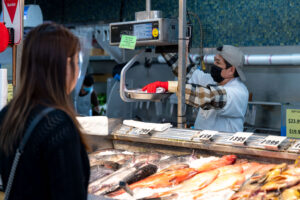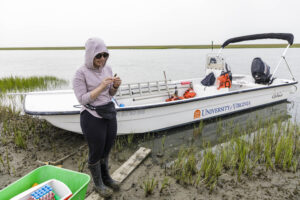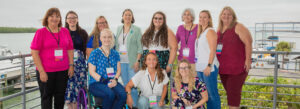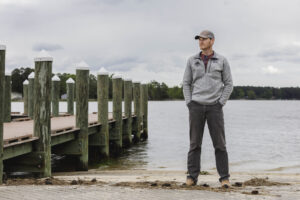Seven steps to safe seafood:
HACCP training serves as safety net for Virginia Consumers
Safe seafood starts in the water, according to Food Safety Extension Specialist Abigail Villalba, but that’s only the beginning of the process. Food processors have to keep food safe each step of the way—as oysters are transported, fresh fish is filleted, and the final products are cooked, packaged, and stored.
Villalba, a specialist at the Virginia Tech Seafood Agricultural Research and Extension Center, trains seafood processors and regulators in food safety through HACCP training—hazard analysis and critical control points training. She leads HACCP classes throughout the year, assisted by other food safety professionals like Farah Monis, a shellfish specialist with the Virginia Department of Health.
“Basically, the HACCP plan tells the operator what to do,” Monis said. “But the steps are based in science to reduce, eliminate, and minimize hazards in a product. Then, records verify that their HACCP plan is working for their operation.”
Each HACCP training covers seven steps: identify food hazards, determine what steps can control these hazards, the critical limits needed to eliminate the hazards, and establishing monitoring procedures, corrective actions, verification procedures, and record-keeping. Together, the seven steps create a safety net of reliable procedures to quickly catch and correct any food safety issues.
A HACCP plan for a steamed crab product would indicate the time, temperature, and amount of crabs that could be steamed at once to eliminate the potential hazard of harmful bacteria. It would also indicate how the steamer will be monitored, what thermometers or steam pressure gauges need to be checked for accuracy, and what records need to be kept to document the process.
“If there’s a recall on a product, then you can pull out all your records and say, ‘It was not my fault, because here, I have the whole history of me processing all these products,’” Villalba, a Virginia Sea Grant extension specialist, said.
During the small classes, Villalba and the other instructors go over each part of the HACCP plan in detail, answer situation-specific questions, and guide the group in developing example plans. Every Virginia shellfish dealer is required to have a HACCP plan, but a low-risk product may not have as many potential hazards as a higher risk product. For example, a shucking-house HACCP plan may need more detail than a dealer who just repacks and ships the shellfish.
For seafood dealers like Kent Carr, who has worked in the oyster harvesting, processing, and distribution business for 40 years, the class helped him understand how the detailed steps resulted in a safer product.
Together, the seven steps create a safety net of reliable procedures to quickly catch and correct any food safety issues.
“This class gave me more of a clear picture of why the regulations are put on there, and what the effects were,” Carr said. “I understand the nitty gritty of the regulations—like icing the oysters down and getting the temperature down. Unless you’ve had Vibrio or been through it, you don’t realize what it is, but after you see pictures and see what it does to people, you know how important it is.”
For regulators like Katie Pulley, an environmental health specialist who inspects restaurants, the HACCP training taught her the ins and outs of HACCP plans for seafood processing.
“We’re in a big seafood area, so it just makes sense,” Pulley said. “If there’s a restaurant that wants to do some sort of seafood processing, then we have the information to give them.”
The detailed plans, from labeling allergens to double-checking cooking equipment—and keeping records of it all, work together to keep seafood products safe for consumers.
“It’s a very convoluted process to put a safe and wholesome product on your table,” Villalba said.
Takeaways:
- HACCP plans provide seafood processors with science-based steps to identify and reduce foodbourne hazards like harmful bacteria or unlabeled allergens.
- During the classes, instructors go over each part of the HACCP plan in detail, answer questions, and guide the group in developing example plans.
- Class participants include seafood processors, distributors, and regulators who conduct food safety inspections.
Photo and Video by Aileen Devlin | Virginia Sea Grant
Written by Madeleine Jepsen | Virginia Sea Grant
Published Nov. 11, 2020.
“This class gave me more of a clear picture of why the regulations are put on there, and what the effects were,” Carr said.






